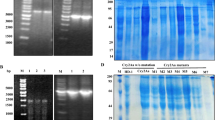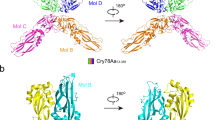Abstract
Bacillus thuringiensis insecticidal crystal proteins (ICPs) and vegetative insecticidal proteins (VIPs) have been widely used as a kind of safe bio-insecticides. A problem that has been of concern worldwide is how to improve their insecticidal activities. In this study, to determine the synergism between VIPs and ICPs effect on insecticidal activity, a construct that produces a chimeric protein of the Vip3Aa7 and the N terminus ofCry9Ca, named V3AC9C, was expressed in Escherichia coli BL21 cells. In additional experiments, the V3AC9C chimeric protein, the single Vip3Aa7, and the single N terminus of Cry9Ca were treated with trypsin. SDS–PAGE showed that the V3AC9C could be processed into two single toxins. Bioassays tested on third instar larvae of Plutella xylostella showed that the toxicity of the chimeric protein was markedly better than either of the single toxins. Interestingly, the toxicity of the chimeric protein was 3.2-fold higher than a mixture of the Vip3Aa7 and Cry9Ca toxins (mass ratio of 1:1). The synergism factor (SF) of chimeric protein containing Vip3Aa7 and Cry9Ca was calculated to be 4.79. The SF in mixture of toxins is only 1.46. Hence, the effect was more than the sum of the Vip3Aa7 and Cry9C activities. Analysis of the protein’s solubility showed that the Vip3Aa7 helped the N terminus of Cry9Ca to dissolve in an alkaline buffer. It was concluded that the increase in the toxicity of the V3AC9C chimeric protein over the constituent proteins mainly resulted from this increase in solubility. These results lay a foundation for the development of a new generation of bio-insecticides and multi-gene transgenic plants.




Similar content being viewed by others
References
Boonserm P, Davis P, Ellar DJ, Li J (2005) Crystal structure of the mosquito-larvicidal toxin Cry4Ba and its biological implications. J Mol Biol 348:363–382
Boonserm P, Mo M, Angsuthanasombat C, Lescar J (2006) Structure of the functional form of the mosquito larvicidal Cry4Aa toxin from Bacillus thuringiensis at a 2.8-angstrom resolution. J Bacteriol 188:3391
Bravo A, Gomez I, Conde J, Munoz-Garay C, Sanchez J, Miranda R, Zhuang M, Gill SS, Soberon M (2004) Oligomerization triggers binding of a Bacillus thuringiensis Cry1Ab pore-forming toxin to aminopeptidase N receptor leading to insertion into membrane microdomains. Biochim Biophys Acta 1667:38–46
Bravo A, Gill SS, Soberon M (2007) Mode of action of Bacillus thuringiensis Cry and Cyt toxins and their potential for insect control. Toxicon 49:423–435
Cai Q, Liu Z, Sun M, Wei F, Yu Z (2002) The analysis of Bacillus thuringiensis vegetative insecticidal protein gene cloning and expression. Sheng Wu Gong Cheng Xue Bao—Chin J Biotechnol 18:578
Chen J, Yu J, Tang L, Tang M, Shi Y, Pang Y (2003) Comparison of the expression of Bacillus thuringiensis full–length and N–terminally truncated vip3A gene in Escherichia coli. J Appl Microbiol 95:310–316
Crickmore N, Zeigler D, Feitelson J, Schnepf E, Van Rie J, Lereclus D, Baum J, Dean D (1998) Revision of the nomenclature for the Bacillus thuringiensis pesticidal crystal proteins. Microbiol Mol Biol Rev 62:807
de Barjac H, Burgerjon A, Bonnefoi A (1966) The production of heat-stable toxin by nine serotypes of Bacillus thuringiensis. J Invertebr Pathol 8:537
Estruch JJ, Warren GW, Mullins MA, Nye GJ, Craig JA, Koziel MG (1996) Vip3A, a novel Bacillus thuringiensis vegetative insecticidal protein with a wide spectrum of activities against lepidopteran insects. Proc Natl Acad Sci U S A 93:5389–5394
Estruch JJ, Yu CG, Warren GW, Desai NM, Koziel MG, Nye GJ (2000) Class of proteins for the control of plant pests (World Intellectual Property Organization Patent WO)
Fahnert B, Lilie H, Neubauer P (2004) Inclusion bodies: formation and utilisation. Physiological Stress Responses in Bioprocesses 93-142
Fang J, Xu X, Wang P, Zhao JZ, Shelton AM, Cheng J, Feng MG, Shen Z (2007) Characterization of chimeric Bacillus thuringiensis Vip3 toxins. Appl Environ Microbiol 73:956–961
Federici B, Park HW, Sakano Y (2006) Insecticidal protein crystals of Bacillus thuringiensis. Inclusions in Prokaryotes. Microbiol Monogr 1:195–236
Gahan LJ, Gould F, Heckel DG (2001) Identification of a gene associated with Bt resistance in Heliothis virescens. Science 293:857–860
Galitsky N, Cody V, Wojtczak A, Ghosh D, Luft JR, Pangborn W, English L (2001) Structure of the insecticidal bacterial delta-endotoxin Cry3Bb1 of Bacillus thuringiensis. Acta Crystallogr D Biol Crystallogr 57:1101–1109
Hofte H, Whiteley H (1989) Insecticidal crystal proteins of Bacillus thuringiensis. Microbiol Mol Biol Rev 53:242
Jurat-Fuentes JL, Adang MJ (2006) Cry toxin mode of action in susceptible and resistant Heliothis virescens larvae. J Invertebr Pathol 92:166–171
Lambert B, Buysse L, Decock C, Jansens S, Piens C, Saey B, Seurinck J, Van Audenhove K, Van Rie J, Van Vliet A (1996) A Bacillus thuringiensis insecticidal crystal protein with a high activity against members of the family Noctuidae. Appl Environ Microbiol 62:80–86
Lee MK, Walters FS, Hart H, Palekar N, Chen JS (2003) The mode of action of the Bacillus thuringiensis vegetative insecticidal protein Vip3A differs from that of Cry1Ab δ-endotoxin. Appl Environ Microbiol 69:4648–4657
Lee MK, Miles P, Chen JS (2006) Brush border membrane binding properties of Bacillus thuringiensis Vip3A toxin to Heliothis virescens and Helicoverpa zea midguts. Biochem Biophys Res Commun 339:1043–1047
Li JD, Carroll J, Ellar DJ (1991) Crystal structure of insecticidal delta-endotoxin from Bacillus thuringiensis at 2.5 A resolution. Nature 353:815–821
Morin S, Biggs RW, Sisterson MS, Shriver L, Ellers-Kirk C, Higginson D, Holley D, Gahan LJ, Heckel DG, Carriere Y, Dennehy TJ, Brown JK, Tabashnik BE (2003) Three cadherin alleles associated with resistance to Bacillus thuringiensis in pink bollworm. Proc Natl Acad Sci U S A 100:5004–5009
Peng D, Xu X, Ruan L, Yu Z, Sun M (2010) Enhancing Cry1Ac toxicity by expression of the Helicoverpa armigera cadherin fragment in Bacillus thuringiensis. Res Microbiol 161:383–389
Pigott CR, Ellar DJ (2007) Role of receptors in Bacillus thuringiensis crystal toxin activity. Microbiol Mol Biol Rev 71:255
Schnepf E, Crickmore N, Van Rie J, Lereclus D, Baum J, Feitelson J, Zeigler DR, Dean DH (1998) Bacillus thuringiensis and its pesticidal crystal proteins. Microbiol Mol Biol Rev 62:775–806
Singh G, Sachdev B, Sharma N, Seth R, Bhatnagar RK (2010) Interaction of Bacillus thuringiensis vegetative insecticidal protein with ribosomal S2 protein triggers larvicidal activity in Spodoptera frugiperda. Appl Environ Microbiol 76:7202
Song R, Peng D, Yu Z, Sun M (2008) Carboxy-terminal half of Cry1C can help vegetative insecticidal protein to form inclusion bodies in the mother cell of Bacillus thuringiensis. Appl Microbiol Biotechnol 80:647–654
Stewart S, Adamczyk J, Knighten K, Davis F (2001) Impact of Bt cottons expressing one or two insecticidal proteins of Bacillus thuringiensis Berliner on growth and survival of noctuid (Lepidoptera) larvae. J Econ Entomol 94:752–760
Tabashnik BE (1992) Evaluation of synergism among Bacillus thuringiensis toxins. Appl Environ Microbiol 58:3343
Terpe K (2003) Overview of tag protein fusions: from molecular and biochemical fundamentals to commercial systems. Appl Microbiol Biotechnol 60:523–533
Waterhouse PM, Graham MW, Wang MB (1998) Virus resistance and gene silencing in plants can be induced by simultaneous expression of sense and antisense RNA. Proc Natl Acad Sci 95:13959
Yu CG, Mullins MA, Warren GW, Koziel MG, Estruch JJ (1997) The Bacillus thuringiensis vegetative insecticidal protein Vip3A lyses midgut epithelium cells of susceptible insects. Appl Environ Microbiol 63:532–536
Zhang X, Candas M, Griko NB, Taussig R, Bulla LA (2006) A mechanism of cell death involving an adenylyl cyclase/PKA signaling pathway is induced by the Cry1Ab toxin of Bacillus thuringiensis. Proc Natl Acad Sci 103:9897
Zhu C, Ruan L, Peng D, Yu Z, Sun M (2006) Vegetative insecticidal protein enhancing the toxicity of Bacillus thuringiensis subsp kurstaki against Spodoptera exigua. Lett Appl Microbiol 42:109–114
Acknowledgments
This work was supported by grants from the National Natural Science Foundation of China (NO. u1170303), the Genetically Modified Organisms Breeding Major Projects of China (2009zx08005-009b), and the Genetically Modified Complex Transgenic Insect-resistant Rice Breeding Foundation of China (2011zx08001-001).
Author information
Authors and Affiliations
Corresponding author
Rights and permissions
About this article
Cite this article
Dong, F., Shi, R., Zhang, S. et al. Fusing the vegetative insecticidal protein Vip3Aa7 and the N terminus of Cry9Ca improves toxicity against Plutella xylostella larvae. Appl Microbiol Biotechnol 96, 921–929 (2012). https://doi.org/10.1007/s00253-012-4213-y
Received:
Accepted:
Published:
Issue Date:
DOI: https://doi.org/10.1007/s00253-012-4213-y




